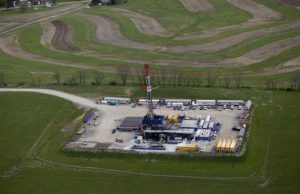Among the nodding donkeys pumping oil out of a field to the West of Midland, Texas, two giant pools of water reflect the clouds dotting the light blue Texas sky above.
This is where Fasken Oil and Ranch recycles the water that it uses to frack its oil wells in the Permian Basin, the largest crude-oil producing region in the US.
Fasken’s operations manager Jimmy Davis likes to show visitors the mobile recycling facility next to the battery of tanks that separate water from oil.
From these tanks, water flows into a container where it is charged with an electric current that causes contaminants to coagulate and fall out. The technology is provided by Water Rescue Services, a company based in Fort Worth, Texas.
The resulting water quality is good enough to allow the water to be reused up to 80 times. According to Davis, more than 3 million barrels of water have been processed since the recycling operation began in July 2013.
In addition to the recycling operation, Fasken filters brackish water from the nearby Santa Rosa aquifer to then be used for fracking. “By the end of June 2014, we had completely discontinued the use of fresh water for oil exploration,” says Davis.
Fasken is a trendsetter in an industry that has been heavily criticised by environmentalists. One of the biggest concerns is the enormous amount of water that is being used for hydraulic fracturing. The process, commonly known as fracking, involves blasting a mix of water, sand and chemicals into a well at high pressure to break fossils out of underground shale formations.
At Fasken Oil and Ranch, up to 45,000 barrels of water, more than 7 million litres, are needed to frack one vertical well.
Roughly 20% of the polluted water resurfaces as “flowback” within a few weeks after injection, while water that was trapped in the underground formations comes to the surface over the lifetime of a well.
This “produced water”, which can contain brine, metals and even radioactive materials, is usually injected back into the ground through so-called disposal wells.
Recycling is a relatively new concept in the industry. Out of up to 6 billion barrels of water that were “produced” in 2014 in the Permian Basin, only about 2% were recycled and reused, estimates Francesco Ciulla, a leading energy expert at the industry information service IHS.
Water has long been seen as a cheap commodity, but for companies operating in water-scarce and drought-prone regions such as Texas, this view is changing. ConocoPhillips, Anadarko Petroleum and Apache are among the bigger producers in the state that try to limit their use of fresh water – and ultimately save money – through recycling.
Ciulla’s Energy Insight group at IHS estimates the market in the US for treating fracking water is currently worth US$855 million and will grow more than 7% annually until 2020.
“Even then we would only see a very small portion of fracking water reused, given that the current share is so small”, says Ciulla, who thinks a more substantial shift will occur only after certain conditions are in place. “The price for treatment technologies has to come down to a level that makes their use economical.”
He also points out industry regulators might at some time in the future delay or reject new permits if they believe a formation cannot absorb more water.
Valuable lessons
Recycling does not only help with water conservation, but, if done right, could also help reduce pollution dangers associated with the disposal of fracking water. Dangers such as those anticipated at the Marcellus Shale formation in Pennsylvania, where reports that insufficiently treated water from shale gas operations had been discharged into rivers have caused major concern.
And regulators in Texas are currently questioning some major oil producers in the state after researchers suggested that a recent increase in earthquakes could have been caused by the injection of fracking wastewater into disposal wells.
The US experience could provide valuable lessons for other countries that consider expanding the exploration of shale gas and oil, among them China. According to a report by the World Resources Institute, 61% of the China’s shale resources are in areas that are either arid or under high water stress.
Yet so far, access to water has not constrained the nascent industry in China, and according to Ciulla, the share of reuse there is minimal. He predicts: “Injection into the ground will be the main method, just like in the US and Canada.”
Xinjiang – ‘China’s Texas’
Water shortages haven’t yet slowed down the shale industry’s development in China, says Pete Marsters, an expert on the environmental impacts of unconventional fossil fuel developments who spent a year in Sichuan researching fracking.
But he acknowledges that water issues may become critical once the industry scales up operations in the Tarim Basin in Xinjiang: ”Xinjiang can be looked at as China’s Texas. It is a very dry place.”
Looking into the future, IHS performed internal research on the possible use of reduced-water or even waterless fracking technologies in China.
One such method would be to supplement or replace water with liquefied or “foamed” nitrogen or carbon dioxide, a method already used widely in Canada as well as in a few locations in the US.
But even in North America, it will take many years of research and experiments to tell if there is a waterless future for the shale industry.







